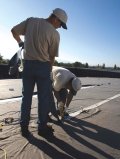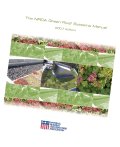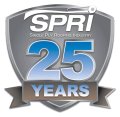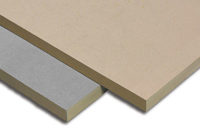
While many architects are not intimately familiar with SPRI and its activities, most have specified roofing systems that meet code requirements based on SPRI recommendations. (Photo courtesy of IB Roof Systems.)

Currently, there is no clear R-value for vegetative roofs because their insulating value strongly depends on their constantly changing water content, according to landscape architect Peter Philippi, a principal with Green Roof Service LLC in Forest Hill, Md. (Photo courtesy of GAF Materials Corporation.)
While many architects are not intimately familiar with SPRI and its activities, most have specified roofing systems that meet code requirements based on SPRI recommendations. As an accredited ANSI (American National Standards Institute) canvasser, SPRI has been extremely active in developing standards for acceptance into the building codes.
Since its inception in 1982, the association has widened its focus from single-ply roofing systems to a variety of other membranes and components, including vegetative roofs, roof gutters, cold adhesives, metal fasteners (corrosion resistance), ballasted roof assemblies,fire and wind resistant roofing, and much more.
To accomplish this, SPRI works closely with a number of industry organizations. These include:
• ARMA (Asphalt Roofing Manufacturers Association)
• FM Global
• ICBO (International Congress of Building Officials)
• MRCA (Midwest Roofing Contractors Association)
• NRCA (National Roofing Contractors Association)
• PIMA (Polyisocyanurate Insulation Manufacturers Association)
• RCI (Institute of Roofing, Waterproofing and Building Envelope Professionals)
• RICOWI (Roofing Industry Committee on Weather Issues) • UL (Underwriters Laboratories Inc.)
• ORNL (Oak Ridge National Laboratory)
• CRRC (Cool Roof Ratings Council)
• USGBC (U.S. Green Building Council)
• Green Roofs for Healthy Cities (GRHC)
Vegetative Roofs
For many architects and specifiers, it’s no longer a matter of whether to consider a vegetative roof for their next project, but what type of design will work best. Next to reflective TPO single-ply membranes, vegetative roofs are the fastest growing system in the low-slope roofing market.
“We estimate that the actual growth rate for vegetative roofs significantly exceeds the 25 percent reported for 2007,” says Steve Peck of Green Roofs for Healthy Cities (GRHC). “We project much greater increases in industry growth and coverage in the years ahead.”
“Few people in the roofing industry doubt that we are in the beginning stages of enormous change,” adds roofing contractor Mark Gaulin, founder of MACGO Inc. and former president of the National Roofing Contractors Association (NRCA). “This is being brought about by the green roofing movement and the realization that buildings play a vital role in conserving energy and protecting the environment.”
The roofing industry is also working quickly to see that vegetative roofs meet all necessary building codes. Organizations like SPRI are working on standards for both wind and fire resistance of vegetative roofs (rooftop gardens).
In September 2007, SPRI, in alliance with GRHC, initiated the development of a wind standard for vegetative roofs under ANSI guidelines. A fire standard for vegetative roofs, which is a design guideline rather than a testing protocol, will follow the wind document.
Here’s a quick summary of SPRI activities in this area:
• Developing definitions for specifiers and others that will help take the mystery out of vegetative roofs and the term’s relationship to cool roofs, roof gardens, and energyefficient roofing.
• Developing a root barrier test method for ANSI certification built off the German FLL standard and adjusted for the United States. In reaction to a code change put into the International Code Council (ICC) stating all vegetative roof systems must undergo wind and fire testing, standards are in development to address these criteria:
• The SPRI RP-14 is the wind standard that is being built off the RP-4 ballasted wind design standard, since both systems are technically ballasted roof assemblies. There are provisions to address the small stone found in the soil media used in vegetative roofs.
• The SPRI VF-1 standard is for fire control designs to limit the spread of fire if a vegetative roof system were to catch fire. This standard uses barriers of non-vegetative zones to contain the fire.
• SPRI is studying the thermal performance of vegetative roofs. Oak Ridge National Laboratory will again be conducting the tests for SPRI, using the just-completed ballast study platforms. This study will quantify the actual performance of the vegetative roof, as it contributes to the thermal resistance of the building.
“Right now, there is no clear R-value for vegetative roofs, because their insulating value strongly depends on their constantly changing water content,” says Philippi. “So building engineers have to do the math for the roof insulation without the vegetative roof and consider the overburden as added R-value.”
Exactly what the overburden contributes will be the focus of the Oak Ridge study.

The NRCA Green Roof Systems Manual- 2007 Edition provides technical information on the design and installation of vegetative roof systems. To order, visit www.nrca.net.
IBC Changes Impact Specifiers
On the national level, SPRI is working to influence two areas of the International Building Code (IBC) that should be of significant interest to roofing specifiers:1. There is currently a table in the IBC that specifies where stone ballasted roofs can be installed. In some instances, this table is more restrictive than the requirements of the national consensus standard, ANSI/SPRI RP-4; in other cases, it is less restrictive. This table was included in the code due to a concern for gravel blowing off roofs in windstorms. No data is available to indicate that roofs designed in accordance with RP-4 have exhibited this type of problem. It is SPRI’s position that the ANSI/SPRI RP-4 already addresses this issue, and all specifiers need to do is reference the document. Proposed code changes for the 2007/2008 code cycle will address this issue.
2. Requirements have been included in the IBC to evaluate the wind and fire performance of vegetative roof systems. None of the currently available standards for evaluating roof systems for these characteristics are adequate for evaluating vegetative roof systems. In addition to the limitations of current test procedures, the numbers of variables are overwhelming. SPRI is working with GRHC to determine how to best address these new code requirements.
3. “Wind Design Standard Practice for Roofing Assemblies,” BSR/SPRI WD-1 2007, is now an approved ANSI standard. This standard provides a two-part methodology of designing for wind uplift resistance of non-ballasted built-up, modified bitumen, and single-ply roofing ing system assemblies installed over any type of roof deck. It also provides recommendations for enhancing the perimeter and corner regions of the roof to resist the greater wind loads that occur in these areas. SPRI has submitted a proposed code change to include this standard in the International Building Code.
SPRI is working on two issues with the California Energy Commission’s (CEC’s) Energy Code requirements.
1. In all but two of the climate zones in California, the energy code includes prescriptive requirements for the use of cool (highly reflective) roof systems. By law, the Commission must ensure that the requirements of the energy code are cost effective. However, the cost effectiveness of the prescriptive requirement for cool roofing systems is being challenged. SPRI is working to determine the most effective manner in which to obtain installed cost information for cool single-ply roofing systems to provide to the CEC.
2. SPRI is also working with the CEC to allow ballasted roofing systems to be considered an approved alternate to cool roof systems where they are currently included as a prescriptive requirement. The basis for this request is a study completed by SPRI after three years of aging studies at ORNL that concludes that due to the thermal mass of ballasted roof systems, they provide energy performance equivalent to highly reflective roof systems after two years of aging.
In Florida, SPRI is working with the Florida Building Commission to continue to allow the use of ballasted roofing systems, which have been proven effective both from an installed cost standpoint and a performance standpoint in the State of Florida.
Metal Fasteners in Treated Wood
SPRI is also undertaking a study to evaluate the effect of various types of wood preservative treatments on metal fasteners and components used in commercial roofing applications.
Much concern has been expressed that some of the new wood treatments will cause certain types of metal that come in contact with them to corrode, leading to failure of the metal component. Since treated wood is commonly used as a nailer in commercial roofing applications, this study will determine the temperature/ humidity conditions that exist at the nailer location in four different climate zones, the Northeast, the Northwest, the Southeast and the Southwest. This information will help determine the corrosion potential of various types of wood treatments, since temperature and humidity trigger corrosion.
Other SPRI standards-in-progress include:
• ANSI/SPRI RP-4, “Wind Design Standard for Ballasted Single-Ply Roofing Systems.” This standard was first developed by RMA and SPRI and approved as an American National Standard in 1987. It was revised and reaffirmed in most recently in 2003. SPRI is now canvassing this standard to revise and affirm it in accordance with ANSI requirements.
• BSR/SPRI/FM4435-ES-1, “Wind Design Standard for Edge Systems Used With Low Slope Roofing Systems.” This standard provides the basic requirements for wind load resistance testing and design for roof edge securement, flashing systems and nailers. It also provides minimum fascia thicknesses that lead to satisfactory flatness, and designs to minimize corrosion are included. It is intended for use with the specifications and requirements of the manufacturers of the specific roofing materials and the edge systems used in the roofing assembly, excluding gutters.
• BSR/SPRI GD-1, “Design Standard for Gutter Systems Used with Low-Slope Roofs.” The proposed standard specifies structural design for gutters used with lowslope roofing. The standard does not address water removal or the water-carrying capability of the gutter, as other building codes already address this issue.
All ANSI/SPRI standards are available to architects at no charge fromwww.spri.org/publications.

SPRI Wind Design Seminars
In addition to providing information on these relevant issues, SPRI continues to offer industry-leading wind design seminars. As part of its agenda for 2008, SPRI is also looking into the feasibility of online continuing education programs so that it can provide a bigger distribution platform for its technical information.“It is my belief that SPRI will continue to be the preeminent technical resource for sheet membrane and related component suppliers in the commercial roofing industry because of the contributions made by its members,” says outgoing SPRI President Mark DeFreitas.
“I would like to invite those specifiers involved in the roofing industry to consider joining SPRI and in turn having a chance to have a direct impact on the next 25 years of commercial roofing.”
For more information about SPRI and its activities, visit www.spri.org or contact the association at info@spri.org.


